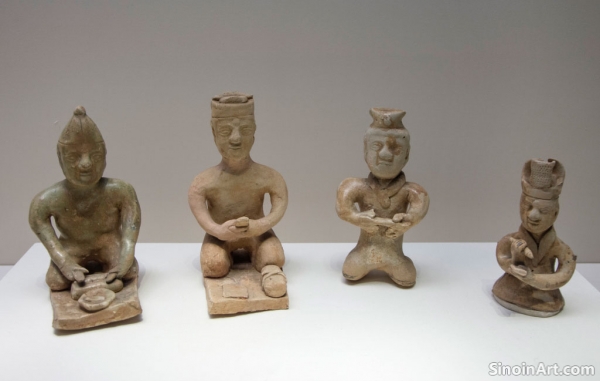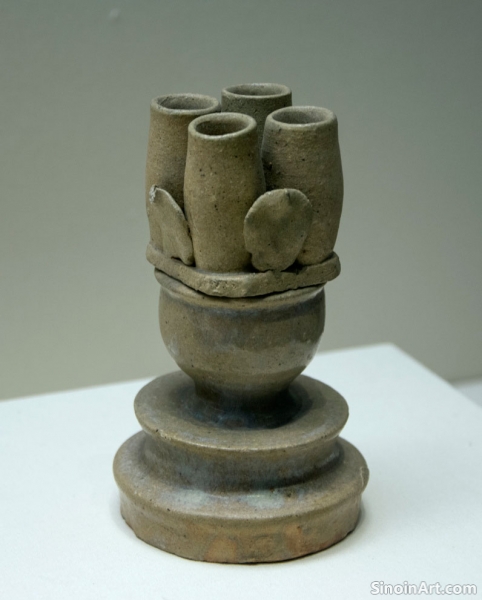The Vibrant World of Tang Ceramics: An Overview
|
The Tang Dynasty (618-907 AD) is considered a golden age in Chinese history, marked by prosperity, cultural exchange, and artistic innovation. Tang ceramics reflect this vibrant era with their diverse forms, bold colors, and dynamic designs. This period saw significant advancements in kiln technology and glazing techniques, leading to a rich variety of ceramic wares. The Tang dynasty was a period of tremendous growth and sophistication in ceramic production.  One of the most distinctive characteristics of Tang ceramics is the use of three-color (sancai) glazes. These lead-based glazes, often in shades of green, amber, and cream, were applied to earthenware figures, vessels, and architectural pieces, creating a striking visual effect. The vibrant colors of sancai are instantly recognizable and often associated with the Tang.  Tang ceramics also encompass a wide range of forms, from elegant ewers and vases to robust storage jars and tomb figurines. These forms often reflect both the practical needs of daily life and the funerary traditions of the time. These forms demonstrate the breadth of artistic production in the Tang. The pottery of this era was used for both secular and religious purposes.  Beyond sancai, Tang potters also produced high-fired wares, including Yue ware celadon, and Changsha ware with its splashed or painted designs. These wares demonstrate the technical sophistication of the period. The Tang potters were innovative and creative in their application of glazes and designs. The legacy of Tang ceramics lies in their artistic innovation, their technical achievements, and their representation of the vibrancy and cosmopolitanism of the Tang Dynasty. They are an important link to the artistic and historical record of the time. These pieces continue to be admired for their beauty and originality. |
Tag : Tang Dynasty ceramics, Chinese ceramics, Sancai pottery, Tang Dynasty art, Chinese pottery
Related information
- The Forms of Tang Ceramics: Function and Artistry
- The Dawn of Celadon Splendor
- The Influence of Foreign Cultures on Tang Ceramics
- The Enduring Legacy of Tang Dynasty Ceramics
- Sancai Glazes: A Tang Dynasty Innovation
Tang Dynasty ceramics feature diverse forms ranging from elegant ewers and sancai tomb figures to robust storage jars and architectural elements, showcasing the intersection of function, artistry, and the diverse needs of the era.
The Tang Dynasty (618-907 AD) represents a crucial period in the history of Chinese ceramics, particularly in the development and refinement of celadon wares. While not as dramatically innovative as the later Song dynasty, the Tang era saw a significant leap in kiln technology, material preparation, and artistic understanding that laid the groundwork for future ceramic masterpieces. Celadon, with its subtle green hues reminiscent of jade, enjoyed immense popularity, favored by both the imperial court and the burgeoning merchant class. Tang celadon wasn't just about mimicking jade; it was about capturing the essence of natural beauty and the philosophical ideals of the time.
The Tang Dynasty’s openness to international exchange significantly influenced its ceramics, evident in the adoption of foreign patterns, vessel forms, and decorative techniques, reflecting the cosmopolitan spirit of the era.
The ceramic art of the Tang Dynasty represents a peak in Chinese ceramic history, leaving an enduring legacy that continues to inspire artists, collectors, and scholars today. The innovative techniques, vibrant colors, and elegant forms of Tang wares established a new standard for ceramic production, influencing subsequent generations of potters both in China and around the world.
Sancai glazes, a key Tang innovation, are lead-based, three-color glazes (green, amber, and cream) applied to diverse ceramics, celebrated for their vibrant colors, distinctive textures, and reflection of the Tang Dynasty.